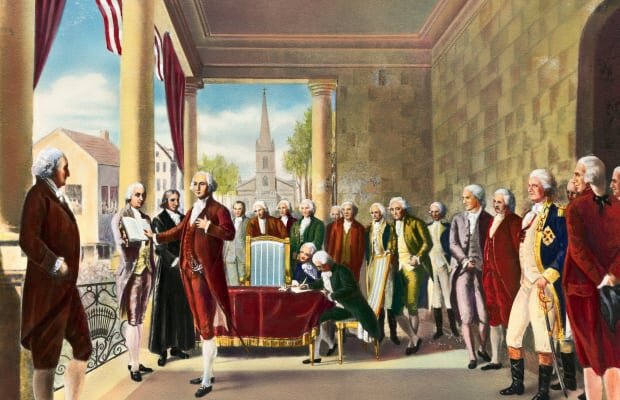Spot of Parchment, October 2020 - President Washington Escaped Death
On October 8, I published an episode on presidents and health for the podcast The Past, The Promise, The Presidency (which I’m co-hosting and co-producing with the Center for Presidential History). I shared a bit of information about George Washington’s health scares while he was president, and the other guests talked about FDR, Eisenhower, Reagan, and George H.W. Bush. I hope you’ll listen, but I wanted to dig into the Washington story a bit more, as well as its implications for the nation.
On April 30, 1789, George Washington took the oath of office as the first president of the United States. While the day was marked by hope and optimism for the future, a heavy sense of anxiety pervaded the air as well. Many Americans felt that this new federal government was the last opportunity the country had to get it right. The Articles of Confederation had already failed and most nations didn’t get a second chance. As students of history, most framers knew that all Republics in history had crumbled and the odds weren’t in their favor.
Washington felt the pressure too. Before leaving Mount Vernon to travel to New York City, he wrote to Henry Knox, saying, “my movements to the chair of Government will be accompanied with feelings not unlike those of a culprit who is going to the place of his execution.” He knew that every action would define precedent for his successors and firmly believed one misstep would doom the presidency and the nation.
From our perch in 2020, that sounds like hyperbole, but many Americans agreed with Washington. Failure was far too likely. So you can imagine their concerns about what might happen if the first president died.
In mid-June, Washington developed a fever and a tumor appeared on his left thigh. The tumor made riding on horseback or in a carriage, sitting, or even lying on his back impossible. Newspapers in Boston, Philadelphia, and New York carried notices of the president’s illness, but offered few details. The Pennsylvania Packet wrote that Washington had been indisposed for several days, but that the editors hoped, “that this indisposition will not prove other than incidental, and the cause be soon removed.”
The Massachusetts Centinel gave a bit more information:
“The publick anxiety has been conspicuously apparent, from some accounts received from New-York, which have mentioned the indisposition of our beloved President…That about the 16th inst. His Excellency was attacked with a slow fever, which continued on him for several days, and was at periods attended with some alarming symptoms—but we are happy to add, he is now in a state of CONVALESCENCE.”
While the newspapers shared the worrying news with citizens across the country, residents in New York also noticed something was amiss. The city had extended a chain across the street in front of Washington’s residence to prevent carriages from passing by. They had also laid down hay to muffle the sound of pedestrian traffic to help facilitate the president’s recovery.
On June 17, Dr. Samuel Bard concluded that the tumor required surgery—a painful and dangerous option given the lack of anesthesia, understanding of germ theory, or disinfectants. Infection was a real possibility. Despite the painful procedure, Washington began to recover and by June 25, he was able to dictate a few letters to his chief secretary, Tobias Lear. A few weeks later, the president was still weak, but clearly on the road to recovery.
But that was not the last time Washington’s health posed a threat to the presidency. On April 27, 1790, Washington asked James Madison to stop by the president’s residency, even though the congressman had been sick with the flu. By May 9, Washington was in bed with what he thought was a bad cold. A few days later, his condition worsened into pneumonia. Despite medical advances, pneumonia is still an incredibly dangerous disease in the twenty-first century, and it was even more so in the eighteenth—Benjamin Franklin had recently died from a lung infection. The same doctors that had tended to Franklin were now at Washington’s bedside and desperate hoping for a different result.
On May 15, Senator William Maclay of Pennsylvania visited the president and wrote in his diary that everyone in the room hovered around the presidency, terrified about what might happen to him. Although Washington’s condition was severe, he started to improve the next day. It took him several weeks to regain his energy and normal routine.
And yet again, one year later, during the summer of 1791, the tumor on Washington’s leg returned and had to be excised again. He recovered more quickly this time, but that fall, his niece wrote that “the President looks better than I expected to see him, but still there be traces in his countenance of his two last severe illnesses, which I fear will never wear off.”
After 1791, Washington enjoyed relatively good health for the remainder of the presidency, and yet the fear lingered. At each moment, the country’s future had laid in the balance. Most eighteenth-century transitions of power were accompanied by guillotine, revolution, death, and a whole lot of drama. No one was sure if the transition from president to vice president would go smoothly. Not to mention, Vice President John Adams wasn’t nearly as popular as Washington, especially in the early years of Washington’s administration.
Thankfully, the country didn’t have to find out what would have happened in the event of Washington’s death while in office. But it’s an important reminder that history is not predetermined or guaranteed. There are lots of twists and turns along the way.

